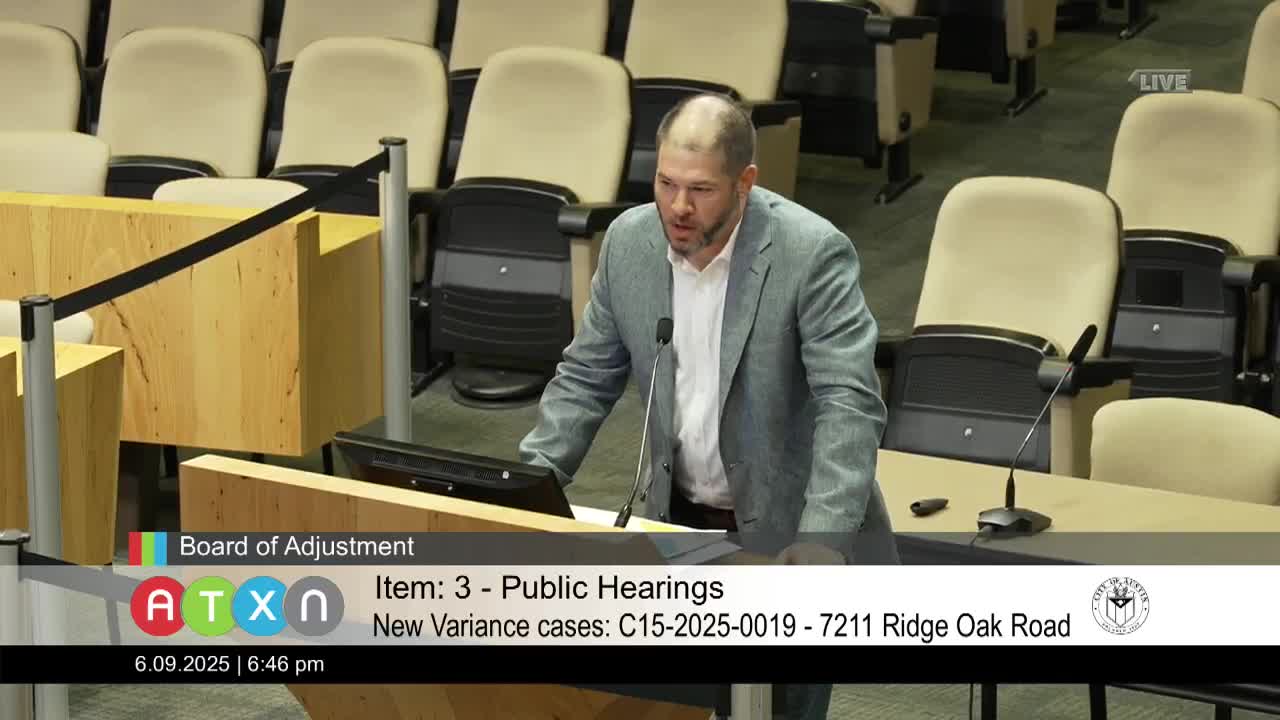Austin residents dispute HOA fence height variance at zoning board meeting
June 09, 2025 | Austin, Travis County, Texas
This article was created by AI summarizing key points discussed. AI makes mistakes, so for full details and context, please refer to the video of the full meeting. Please report any errors so we can fix them. Report an error »

The Austin Board of Adjustment convened on June 9, 2025, to address a contentious issue regarding a fence variance request that has sparked significant community debate. The meeting featured testimonies from residents, including the applicant and several neighbors, focusing on the implications of the proposed fence height on neighborhood aesthetics and safety.
The applicant, who has lived in the area for 13 years, expressed frustration over the construction of a fence that exceeds the city’s height regulations. Initially, the neighbors sought to build an 8-foot-4-inch fence, but the applicant contended that the actual height measures 9 feet 6 inches, which violates local land development codes that stipulate a maximum height of 6 feet unless neighbor consent is obtained. The applicant claimed that consent was not given by adjacent neighbors, raising concerns about the lack of communication and adherence to community standards.
During the meeting, the applicant presented arguments against the fence's height, stating it obstructs views and diminishes property value. They highlighted that the fence's construction occurred despite warnings from the Homeowners Association (HOA) about its non-compliance with neighborhood regulations. The applicant also noted that the fence creates a safety hazard for children, as it is now higher than the previously existing fence, which could lead to increased risk of falls.
Another resident, Nancy Ellis, voiced her concerns about the potential precedent this variance could set for the neighborhood, fearing it could lead to a proliferation of similarly tall fences, disrupting the community's character. She emphasized that most homes in the area are built on sloped terrain, which complicates the issue of fence height and visibility.
In response, the applicant's representatives argued that the HOA had initially approved the fence, contingent upon neighbor approval, and that several neighbors had expressed support for the variance. They maintained that the increased height was necessary for privacy and safety, particularly due to the unique topography of their property.
Board members engaged in a thorough discussion, questioning the applicant about the rationale behind the fence's height and the process followed in its construction. They sought clarification on whether alternative solutions, such as a stepped fence design that follows the natural slope of the land, had been considered.
As the public hearing concluded, the board members deliberated on the implications of granting the variance, weighing the applicant's claims against community standards and safety regulations. The outcome of this meeting remains to be seen, as the board will need to consider both the individual circumstances of the applicants and the broader impact on the neighborhood.
The applicant, who has lived in the area for 13 years, expressed frustration over the construction of a fence that exceeds the city’s height regulations. Initially, the neighbors sought to build an 8-foot-4-inch fence, but the applicant contended that the actual height measures 9 feet 6 inches, which violates local land development codes that stipulate a maximum height of 6 feet unless neighbor consent is obtained. The applicant claimed that consent was not given by adjacent neighbors, raising concerns about the lack of communication and adherence to community standards.
During the meeting, the applicant presented arguments against the fence's height, stating it obstructs views and diminishes property value. They highlighted that the fence's construction occurred despite warnings from the Homeowners Association (HOA) about its non-compliance with neighborhood regulations. The applicant also noted that the fence creates a safety hazard for children, as it is now higher than the previously existing fence, which could lead to increased risk of falls.
Another resident, Nancy Ellis, voiced her concerns about the potential precedent this variance could set for the neighborhood, fearing it could lead to a proliferation of similarly tall fences, disrupting the community's character. She emphasized that most homes in the area are built on sloped terrain, which complicates the issue of fence height and visibility.
In response, the applicant's representatives argued that the HOA had initially approved the fence, contingent upon neighbor approval, and that several neighbors had expressed support for the variance. They maintained that the increased height was necessary for privacy and safety, particularly due to the unique topography of their property.
Board members engaged in a thorough discussion, questioning the applicant about the rationale behind the fence's height and the process followed in its construction. They sought clarification on whether alternative solutions, such as a stepped fence design that follows the natural slope of the land, had been considered.
As the public hearing concluded, the board members deliberated on the implications of granting the variance, weighing the applicant's claims against community standards and safety regulations. The outcome of this meeting remains to be seen, as the board will need to consider both the individual circumstances of the applicants and the broader impact on the neighborhood.
View full meeting
This article is based on a recent meeting—watch the full video and explore the complete transcript for deeper insights into the discussion.
View full meeting
